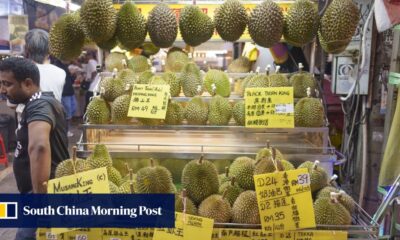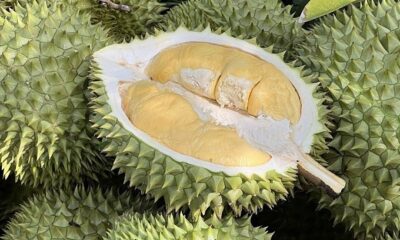China
China is the world’s worst jailer of journalists, CPJ says

China is the worst jailer of journalists in the world, a report by a New York-based watchdog said, and nearly half of the journalists behind bars in the country are Uyghurs who reported on the persecution of the mostly Muslim group in Xinjiang.
In its 2023 prison census, conducted on Dec. 1, the Committee to Protect Journalists, or CPJ, found that there was a spike in arrested journalists, with 320 believed to be behind bars – close to a record high.
More than half of those jailed journalists were charged with false news, anti-state or terrorism charges in retaliation for their coverage, the group’s research found.
China led all countries, with 44 journalists in prison, accounting for 32% of the worldwide total. Following closely behind was Myanmar, with 43. Vietnam was fifth on the list with 19, ahead of Iran and just behind Russia.
“China has long ranked as one of the world’s worst jailers of journalists,” the report said. “Censorship makes the exact number of journalists jailed there notoriously difficult to determine, but Beijing’s media crackdown has widened in recent years, with 2021 marking the first time journalists from Hong Kong were in jail at the time of CPJ’s census.”
In addition to Hong Kong, Xinjiang was another chief area of concern, according to the report. Of the 44 imprisoned journalists in China, 19 are Uyghurs.
Among them is Ilham Tohti, a professor who was also the founder of the news website Uighurbiz. Tohti was arrested almost exactly 10 years ago, and later sentenced to life in prison on charges of separatism.
Another is Qurban Mamut, the former editor-in-chief of the popular Uyghur journal Xinjiang Civilization. Mamut went missing in November 2017 and RFA learned in 2022 that he was sentenced to 15 years in prison for “political crimes.”

“Chinese authorities are also ramping up the use of anti-state charges to hold journalists, with three out of the five new China cases in CPJ’s 2023 database consisting of journalists accused of espionage, inciting separatism, or subverting state power,” the report said.
“Many journalists charged are ethnic Uighurs from Xinjiang, where Beijing has been accused of crimes against humanity for its mass detentions and harsh repression of the region’s mostly Muslim ethnic groups,” it said.
‘Silencing minority voices’
The disproportionate number of jailed Uyghur journalists mirrors the situation in Xinjiang, Beh Lih Yi, the CPJ’s Asia program coordinator told RFA Uyghur.
“Nearly half of the journalists behind bars in China in 2023 were Uighur journalists. They have been targeted under vague charges such as inciting separatism or being ‘two-faced,’ a loose term Chinese authorities often use to punish those they see as publicly supporting government policy but secretly opposing it,” said Yi.
“The media repression highlights the Chinese government’s harsh attempt to silence minority voices and independent reporting – even as Beijing repeatedly rejected claims of widespread human rights abuses in Xinjiang,” he said.

He said that long-term sentences for Uyghur journalists were “outrageous and cruel,” and called on the Chinese government to release all its imprisoned journalists and allow all journalists to freely report in Xinjiang.
The report proves the importance of the work of Uyghur journalists, Zubayra Shamseden of the Washington-based Uyghur Human Rights Project said.
“It is clear from the imprisonment of Uyghur journalists that China doesn’t want the international community to know anything about Uyghurs,” said Shamseden. “Uyghur journalists report on Uyghur issues. They are the voices of the Uyghur people in the world. By imprisoning Uyghur journalists, China is attempting to crush the voices of Uyghurs.”
The report also noted that Israel saw a huge spike of journalist jailings last year, with all those known to be behind bars on the date of the census having been arrested in the West Bank.
Additional reporting by Mamatjan Juma. Edited by Malcolm Foster.
Read the rest of this article here >>> China is the world’s worst jailer of journalists, CPJ says
China
Analyzing China’s Foreign Direct Investment (FDI) Performance in the First Half of 2024

China’s H1 2024 FDI data shows a decline in utilized FDI amount but an increase in the number of newly registered FIEs. Germany and Singapore increased investment, with a focus on high-tech manufacturing and professional services reflecting growing interest in China’s innovation-driven industries.
According to recent data from China’s Ministry of Commerce (MOFCOM), the country’s foreign direct investment (FDI) performance in H1 2024 presents a mixed picture. While the actual utilized FDI amount declined by 29.1 percent year-on-year to RMB 498.9 billion (equivalent to US$69.93 billion), the number of newly registered foreign-invested enterprises (FIEs) reached 26,870, reflecting a 14.2 percent increase year-on-year. Notably, investment from Germany and Singapore in China increased by 18.1 percent and 10.5 percent, respectively, during the January to June period, highlighting the strategic focus of these nations in the Chinese market.
In this article, we delve into China’s H1 2024 FDI data, examining the latest trends and challenges. We also explore strategic opportunities for foreign investors within the current economic landscape. As China prioritizes attracting investment in high-tech manufacturing, modern services, and green energy, understanding these dynamics is crucial for making informed decisions in this evolving market.
High-tech manufacturing, a key focus area for China’s economic strategy, also saw positive developments. FDI in this segment reached RMB 63.8 billion (US$8.94 billion), which constituted 12.8 percent of the total FDI for the period. This figure reflects a year-on-year increase of 2.4 percentage points, indicating growing foreign interest in China’s high-tech and innovation-driven industries. This growth aligns with China’s broader push towards advancing technological capabilities and fostering innovation as part of its economic transformation.
Particularly noteworthy are the substantial FDI inflows into specific segments such as medical instrument manufacturing and professional technical services. In the medical instrument sector, FDI surged by 87.5 percent, highlighting the increased foreign investment in healthcare technology and medical innovations. This growth reflects the sector’s expanding role in China’s healthcare system and its attractiveness to global investors seeking to capitalize on the country’s advancing medical infrastructure.
Similarly, the professional technical services sector saw a significant 43.4 percent increase in FDI, underscoring the rising demand for specialized services and expertise. This growth points to a broader trend of increased foreign engagement in sectors that support technological and professional advancements within China.
Between January and June 2024, investment from Germany and Singapore in China increased by 18.1 percent and 10.5 percent, respectively. This growth highlights a rising interest from these nations even as overall FDI experienced a broader decline.
This article is republished from China Briefing. Read the rest of the original article.
China Briefing is written and produced by Dezan Shira & Associates. The practice assists foreign investors into China and has done since 1992 through offices in Beijing, Tianjin, Dalian, Qingdao, Shanghai, Hangzhou, Ningbo, Suzhou, Guangzhou, Dongguan, Zhongshan, Shenzhen, and Hong Kong. Please contact the firm for assistance in China at china@dezshira.com.
China
Rescue Efforts Won’t Address the Fundamental Issues in China’s Property Market
On May 17, 2024, China introduced measures to stabilize its declining property sector, facing a 3.9% drop in new house prices. Structural reforms are needed for lasting recovery.
China’s Efforts to Revitalize the Property Sector
On May 17, 2024, China implemented a series of measures designed to stabilize its beleaguered property market, which experienced a 3.9% year-on-year decline in new house prices that month. This downturn threatens not only the property sector but also the broader economy, increasing concerns about financial stability. Despite the government’s interventions, challenges such as high household leverage, steep property price-to-income ratios, and demographic shifts are likely to exert continued downward pressure on prices. Addressing the structural issues in the property market necessitates reforms in land allocation, financial regulations, and urbanization strategies.
The newly introduced measures include reducing downpayment requirements, lowering mortgage rates, and easing purchase conditions. Local governments have also been tasked with buying unsold properties to convert into social housing. These actions come as new home prices in 70 cities fell by an average of 3.9% year-on-year and 0.7% month-on-month, reflecting a troubling trend across the majority of regions surveyed.
While the measures are a timely response to declining property values, their immediate impact remains to be seen. The real estate sector plays a critical role in China’s economy, contributing significantly to GDP and local government revenues. Leading indicators suggest some signs of recovery in property demand, but unfavorable economic fundamentals still pose challenges for the effectiveness of these rescue efforts. Further data in June may reveal the true impact of these policies.
Source : Rescue measures won’t fix the structural problems in China’s property market
Business
Malaysia Launches ‘Luxury’ Durian Exports to China as Indonesia Eyes Market Opportunities

Malaysia has begun exporting fresh durian to China, targeting high-end consumers with 40 tonnes shipped in phases. China, the largest durian buyer, may eventually import from Indonesia pending compliance with standards.
Malaysia’s Fresh Durian Shipment to China
Malaysia has successfully sent its first shipment of fresh durians to China, aiming to capture the interest of a market largely supplied by Thailand and Vietnam. This shipment includes 40 tonnes released in three phases, as announced by Deputy Agriculture and Food Security Minister Datuk Arthur Joseph Kurup. China represents the world’s largest durian importer, having purchased 1.4 million tonnes last year, with a significant portion sourced from Thailand.
Emphasis on Quality
Malaysian exporters, having met China’s phytosanitary requirements, are focusing on the quality of their products rather than sheer volume. Lim Chin Khee from the Durian Academy states that Malaysian durians are considered luxury items, targeting high-end consumers. The first shipment of 20 tonnes has already reached the Zhengzhou Xinzheng International Airport, fetching prices that can reach 200 yuan (approximately $28) per fruit.
Indonesia’s Durian Prospects
Indonesia is also exploring opportunities in the Chinese durian market, with discussions surrounding compliance to China’s phytosanitary standards ongoing. As reported, Indonesian officials are eager to establish a protocol that could facilitate durian exports, considering the strong demand in China. Lynn Song from ING emphasizes that should these negotiations succeed, Indonesian durians could effectively carve a niche in the burgeoning market.
Source : Malaysia starts ‘luxury’ durian exports to China as Indonesia sniffs the market






